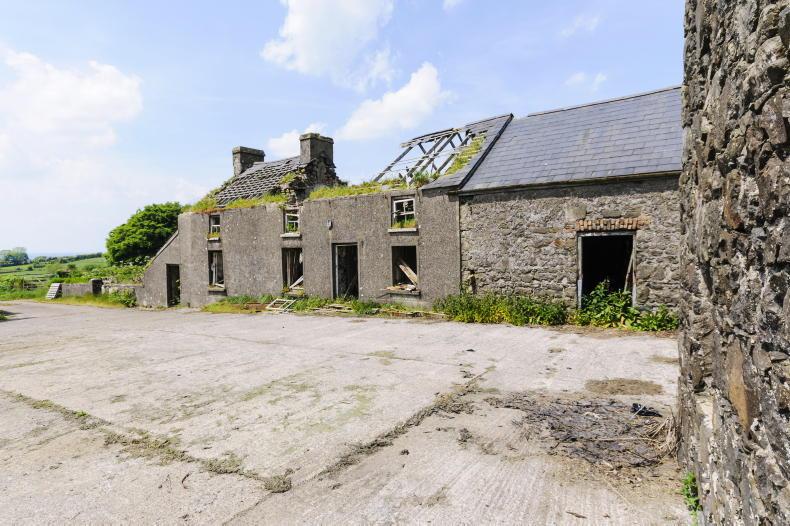There is an old dwelling on the farm, it was where my grandfather was born but at under 500sq ft, it’s very small. Would it be ok to add an extension? We may have to knock a wall to do so. Is that ok?
Yes, you can extend the building. It is important to note that although you can demolish part of the building, you cannot demolish the whole thing. The purpose of the scheme is to refurbish old buildings as opposed to creating whole new ones.
For the derelict component what needs to be kept of the original structure?
While demolition and extension works can form part of an application for the Vacant Property Refurbishment Grant (VPRG), such works must be part of a wider refurbishment of the existing dwelling in keeping with the objectives of the scheme
Can I still apply for Sustainable Energy Authority of Ireland (SEAI) grant?
You can still apply for the SEAI grant and it is an important consideration in your build as it is worth between €24,000 and €30,000 depending on the type of property. However, it is important to note that it cannot be paid on the same works that the VPRG covers.
My husband and I purchased an old farm recently and there are two old dwellings in the yard. One hasn’t been lived in for 20 years and the other is a much older structure. We plan to live there and maybe rent out the second house. Would it be possible for us to draw down the grant on each building?
Yes. Grant aid for the scheme can be drawn down across two properties by the same applicant. However, one of the dwellings must be the applicant’s principal primary dwelling. If you are renting the other property, a tenancy must be registered with the Residential Tenancy Board prior to the grant issuing. The grant is also restricted to individuals, with companies and organisations ineligible.

It’s very hard to find anyone doing a trade in my locality and I don’t think I will be able to get the job done within 13 months. What will happen in that circumstance?
The reason that this timeline is in place is to ensure the work gets done in a timely fashion. It is to avoid situations where a person gets approved but then sits on it for five years, for example, before getting the work done. So, the time allocation to do works is 13 months. However, discretion is being applied by local authorities in recognition of the challenges of finding a builder.
There is a derelict property on my parent’s farm. I don’t own it but my parents said if I want to do it up, they are happy for me to do that. Can I still apply for the grant even though the property is in my parents name?
Only the owner can apply for the grant, so either your parents apply or the property is transferred to you.
What evidence do you have to provide to show that the property is for rent?
Where the applicant is going to make the dwelling available for rent, the declaration (on the Application Form) must be provided to the local authority. You must sign that upon completion of the qualifying works, the property will be made available to rent and that the tenancy will be registered with the Residential Tenancies Board (RTB). Evidence of registration of the tenancy with the RTB must be provided before the grant will be paid. Clawback conditions will apply if the property is no longer available to rent within ten years.
We have a very old farmhouse on our land. How do I know if it would be considered derelict, so I can apply for the higher grant?
There is a Derelict Property Register that you can check through your local county council. If it is not on there, then you would need to provide a report from a qualified professional stating the property is derelict. The investment could well be worth it as if it is considered derelict, you could apply for up to €70,000 as opposed to up to €50,000.
If I get approved for the grant, can I spend the money anyway I want?
There are parameters you should be aware of. So the maximum grant amount can be applied to any of the following works: demolitions and site clearance; substructure works and superstructure works (essentially your foundations and walls), services and an extension. However, there are some areas where there is a maximum spend. Windows and sills for example, are up to €21,000 while a maximum of €2,800 is available for sanitary ware. It’s also worth noting that the max spending rules include VAT when calculating the ceiling of spending.
Our family pub has some accommodation above it that hasn’t been lived in for years. My father is going to apply for the grant and I will live there but there are some works that need to be done throughout. For example, the place needs a whole new heating system. How does that work?
You can apply for the grant to refurbish the accommodation upstairs but the money can only be used for this part of the building. So the grant can only go towards a heating system for the accommodation, not the whole pub.
This is a topic that we will continue to cover and we want to follow a reader through the process from application stage, to the build and then the grand reveal. If you would like to bring Irish Country Living on the journey with you, please email icl@farmersjournal.ie







 This is a subscriber-only article
This is a subscriber-only article










SHARING OPTIONS: